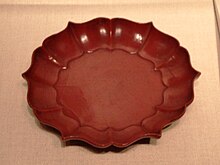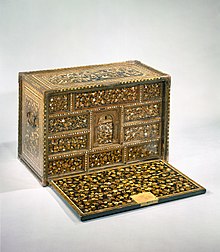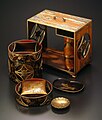 R = (CH2)14CH3 or R = (CH2)7CH=CH(CH2)5CH3 or R = (CH2)7CH=CHCH2CH=CH(CH2)2CH3 or R = (CH2)7CH=CHCH2CH=CHCH=CHCH3 or R = (CH2)7CH=CHCH2CH=CHCH2CH=CH2 and others |
Urushiol /ʊˈruːʃi.ɒl/ is an oily mixture of organic compounds with allergenic properties found in plants of the family Anacardiaceae, especially Toxicodendron spp. (e.g., poison oak, Chinese lacquer tree, poison ivy, poison sumac), Comocladia ssp. (maidenplums) and also in parts of the mango tree as well as the fruit of the cashew tree.
In most individuals, urushiol causes an allergic skin rash on contact, known as urushiol-induced contact dermatitis.
The name urushiol is derived from the Japanese word for the lacquer tree, Toxicodendron vernicifluum (漆, urushi). The oxidation and polymerization of urushiol in the tree's sap in the presence of moisture allows it to form a hard lacquer, which is used to produce traditional Chinese, Korean and Japanese lacquerware.
History
Although urushiol-containing lacquers and their skin-irritating properties were well known in East Asia for several millennia, its first recorded Western texts were in 1624 by John Smith and he initially likened poison ivy to English Ivy. He did not classify it as a poison at first due to the speed with which its rash disappeared and Smith hypothesized that there may actually be medicinal uses for the plant. In the 18th and 19th centuries, many experiments were done in this area to determine whether or not this theory was true. Because that era's medicinal culture was dominated by plant-based treatments, physicians were hopeful that the strong effect this chemical produced on the body could be effective in some way. André-Ignace-Joseph Dufresnoy was one of the first to come up with a medicinal use for this chemical in 1780 when he boiled poison ivy to produce an infusion for internal use. This led to a distilled extract of poison ivy which he prescribed to many people suffering from skin problems and even paralysis. He claimed this treatment to have yielded several positive results.
For many years, poison ivy was thought to fall into the Rhus genus; however, in the 1900s, it was reclassified into a more appropriate genus, Toxicodendron, meaning poison tree. There were many documented cases of irritations and allergic reactions from the plant, and its propensity for medicinal use quickly dwindled. After this new categorization, scientists began attempts to determine what it was that rendered plants of this genus noxious, starting with a hypothesis of a volatile oil present in the plants. While this proved incorrect, Rikou Majima from Japan was able to determine that the chemical urushiol was the irritant. Further, he determined that the substance was a type of alkyl catechol, and due to its structure it was able to penetrate the skin and survive on surfaces for months to years. Urushiol's ability to polymerise into a hard glossy coating is the chemical basis for traditional lacquerware in many Asian countries. After urushiol comes in contact with oxygen, under certain conditions it become a black lacquer and has been named urushi lacquer.
Characteristics
Urushiol in its pure form is a pale-yellow liquid with a specific gravity of 0.968 and a boiling point of 200 °C (392 °F). It is soluble in diethyl ether, acetone, ethanol, carbon tetrachloride, and benzene.
Urushiol is a mixture of several closely related organic compounds. Each consists of a catechol substituted in the 3 position with a hydrocarbon chain that has 15 or 17 carbon atoms. The hydrocarbon group may be saturated or unsaturated. The exact composition of the mixture varies, depending on the plant source. Whereas western poison oak urushiol contains chiefly catechols with C17 side-chains, poison ivy and poison sumac contain mostly catechols with C15 sidechains.
The likelihood and severity of allergic reaction to urushiol is dependent on the degree of unsaturation of the hydrocarbon chain. Less than half of the general population experience a reaction with the saturated urushiol alone, but over 90% do so with urushiol that contains at least two degrees of unsaturation (double bonds). Longer side chains tend to produce a stronger reaction.
Urushiol is an oleoresin contained within the sap of poison ivy and related plants, and after injury to the plant, or late in the fall, the sap leaks to the surface of the plant, where under certain temperature and humidity conditions the urushiol becomes a blackish lacquer after being in contact with oxygen. Urushi lacquer is very stable. It is able to withstand disturbances from alkali, acid, and alcohol, while also being able to resist temperatures of over 300 °C. However, the lacquer can be degraded by UV rays from the sun and other sources.
Within the United States, urushiol-containing plants are distributed throughout. Poison ivy can be found in all states except California, Alaska, and Hawaii. Poison Oak can be found on the west coast or some states in the southeast, while poison sumac can be found only in the eastern half of the country.
These plants all have distinguishing features that will help in identification. Poison ivy always grows with three shiny, pointy leaves. Poison oak has a similar look, but with larger and more rounded leaves that are hairy and grow in groups of 3, 5, or 7. Poison sumac grows in groups of 7 to 13 leaves, but always in an odd number. The leaves are feather-shaped and shiny.
Allergic response and treatment
Before the urushiol has been absorbed by the skin, it can be removed with soap and water. Substantial amounts of urushiol may be absorbed within minutes. Once urushiol has penetrated the skin, attempting to remove it with water is ineffective. After being absorbed by the skin, it is recognized by the immune system's dendritic cells, otherwise called Langerhans cells. These cells then migrate to the lymph nodes, where they present the urushiol to T-lymphocytes and thus recruit them to the skin, and the T-lymphocytes cause pathology through the production of cytokines and cytotoxic damage to the skin. This causes the painful rash, blisters, and itching.
Once this response starts, only a few treatments, such as cortisone or prednisone, are effective. Medications that can reduce the irritation include antihistamines (diphenhydramine (Benadryl) or cetirizine (Zyrtec)). Other treatments include applying cold water or calamine lotion to soothe the pain and stop the itching.
Mechanism of action
To cause an allergic dermatitis reaction, the urushiol is first oxidized to create two double-bonded oxygens on the chemical. It then reacts with a protein nucleophile to trigger a reaction within the skin. Dermatitis is mediated by an induced immune response. Urushiol is too small a molecule to directly activate an immune response. Instead, it attaches to certain proteins of the skin, where it acts as a hapten, leading to a type IV hypersensitive reaction.
Hydrocortisone, the active ingredient in cortisone, works to alleviate this condition by stopping the release of chemicals that cause the dermatitis reaction. Hydrocortisone itself does not react with urushiol in any way.
Use as lacquer
Urushiol-based lacquers differ from most others, being slow-drying, and set by oxidation and polymerization, rather than by evaporation alone. The active ingredient of the resin is urushiol, a mixture of various phenols suspended in water, plus a few proteins. In order for it to set properly it requires a humid and warm environment. The phenols oxidize and polymerize under the action of laccase enzymes, yielding a substrate that, upon proper evaporation of its water content, is hard. These lacquers produce very hard, durable finishes that are both beautiful and very resistant to damage by water, acid, alkali or abrasion. The resin is derived from trees indigenous to East Asia, like lacquer tree Toxicodendron vernicifluum, and wax tree Toxicodendron succedaneum. The fresh resin from the T. vernicifluum trees causes urushiol-induced contact dermatitis and great care is therefore required in its use. The Chinese treated the allergic reaction with crushed shellfish, which supposedly prevents lacquer from drying properly. Lacquer skills became very highly developed in Asia, and many highly decorated pieces were produced.
It has been confirmed that the lacquer tree has existed in Japan since 12,600 years ago in the incipient Jōmon period. This was confirmed by radioactive carbon dating of the lacquer tree found at the Torihama shell mound, and is the oldest lacquer tree in the world found as of 2011. Lacquer was used in Japan as early as 7000 BCE, during the Jōmon period. Evidence for the earliest lacquerware was discovered at the Kakinoshima "B" Excavation Site in Hokkaido. The ornaments woven with lacquered red thread were discovered in a pit grave dating from the first half of the Initial Jōmon period. Also, at Kakinoshima "A" Excavation Site, earthenware with a spout painted with vermilion lacquer, which was made 3200 years ago, was found almost completely intact.
During the Shang Dynasty (1600–1046 BC), the sophisticated techniques used in the lacquer process were first developed and it became a highly artistic craft, although various prehistoric lacquerwares have been unearthed in China dating back to the Neolithic period. The earliest extant Chinese lacquer object, a red wooden bowl, was unearthed at a Hemudu culture (5000–4500 BC) site in China. By the Han Dynasty (206 BC – 220 AD), many centres of lacquer production became firmly established. The knowledge of the Chinese methods of the lacquer process spread from China during the Han, Tang and Song dynasties. Eventually it was introduced to Korea and Japan.
Trade of lacquer objects travelled through various routes to the Middle East. Known applications of lacquer in China included coffins, music instruments, furniture, and various household items. Lacquer mixed with powdered cinnabar is used to produce the traditional red lacquerware from China.
From the 16th century to the 17th century, lacquer was introduced to Europe on a large scale for the first time through trade with Japanese. Until the 19th century, lacquerware was one of Japan's major exports, and European royalty, aristocrats and religious people represented by Marie-Antoinette, Maria Theresa and The Society of Jesus collected Japanese lacquerware luxuriously decorated with maki-e. The terms related to lacquer such as "Japanning", "Urushiol" and "maque" which means lacquer in Mexican Spanish, are derived from Japanese.
The trees must be at least ten years old before cutting to bleed the resin. It sets by a process called "aqua-polymerization", absorbing oxygen to set; placing in a humid environment allows it to absorb more oxygen from the evaporation of the water.
Lacquer-yielding trees in Thailand, Vietnam, Burma and Taiwan, called Thitsi, are slightly different; they do not contain urushiol, but similar substances called laccol or thitsiol. The result is similar but softer than the Chinese or Japanese lacquer. Burmese lacquer sets slower, and is painted by craftsmen's hands without using brushes.
Raw lacquer can be "coloured" by the addition of small amounts of iron oxides, giving red or black depending on the oxide. There is some evidence that its use is even older than 8,000 years from archaeological digs in Japan and China. Later, pigments were added to make colours. It is used not only as a finish, but mixed with ground fired and unfired clays applied to a mould with layers of hemp cloth, it can produce objects without need for another core like wood. The process is called "kanshitsu" in Japan. In the lacquering of the Chinese musical instrument, the guqin, the lacquer is mixed with deer horn powder (or ceramic powder) to give it more strength so it can stand up to the fingering.
There are a number of forms of urushiol. They vary by the length
of the R chain, which depends on the species of plant producing the
urushiol. Urushiol can also vary in the degree of saturation in the
carbon chain. Urushiol can be drawn as follows:
 , where:
, where:
R = (CH2)14CH3 or
R = (CH2)7CH=CH(CH2)5CH3 or
R = (CH2)7CH=CHCH2CH=CH(CH2)2CH3 or
R = (CH2)7CH=CHCH2CH=CHCH=CHCH3 or
R = (CH2)7CH=CHCH2CH=CHCH2CH=CH2
Gallery
A Chinese carved lacquer oval tray, Yuan Dynasty, ca. 13th century.
Ming Dynasty Chinese lacquerware container, dated 16th century.
Clothing box decorated with peony scrolls, Joseon Dynasty Korea, 17th century.
Inro in maki-e Lacquer, Edo period Japan, 18th century
Picnic Box with Design of the Scene from The Tale of Genji in Maki-e Lacquer, Edo or Meiji period Japan, 19th century
Types of lacquer
Types of lacquer vary from place to place but they can be divided into unprocessed and processed categories.
The basic unprocessed lacquer is called raw lacquer (生漆: ki-urushi in Japanese, shengqi in Chinese). This is directly from the tree itself with some impurities filtered out. Raw lacquer has a water content of around 25% and appears in a light brown colour. This comes in a standard grade made from Chinese lacquer, which is generally used for ground layers by mixing with a powder, and a high quality grade made from Japanese lacquer called kijomi-urushi (生正味漆) which is used for the last finishing layers.
The processed form (in which the lacquer is stirred continuously until much of the water content has evaporated) is called guangqi (光漆) in Chinese but comes under many different Japanese names depending on the variation, for example, kijiro-urushi (木地呂漆) is standard transparent lacquer sometimes used with pigments and roiro-urushi (黒呂色漆) is the same but pre-mixed with iron hydroxide to produce a black coloured lacquer. Nashiji-urushi (梨子地漆) is the transparent lacquer but mixed with gamboge to create a yellow-tinged lacquer and is especially used for the sprinkled-gold technique. These lacquers are generally used for the middle layers. Japanese lacquers of this type are generally used for the top layers and are prefixed by the word jo- (上) which means 'top (layer)'.
Processed lacquers can have oil added to them to make them glossy, for example, shuai-urushi (朱合漆) is mixed with linseed oil. Other specialist lacquers include ikkake-urushi (釦漆) which is thick and used mainly for applying gold or silver leaf.










